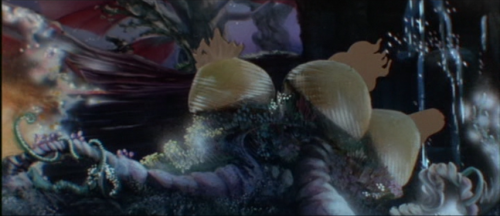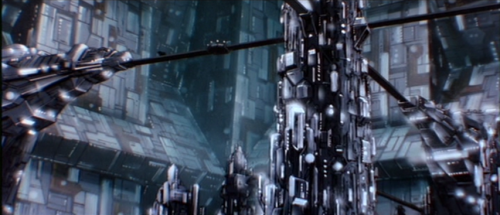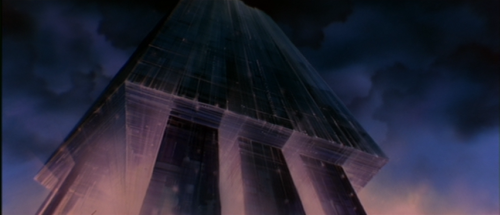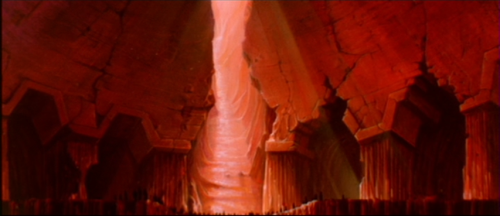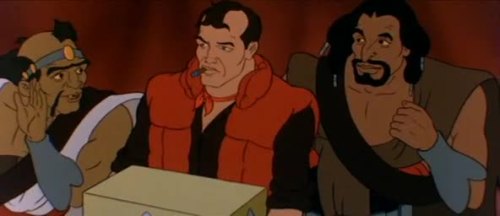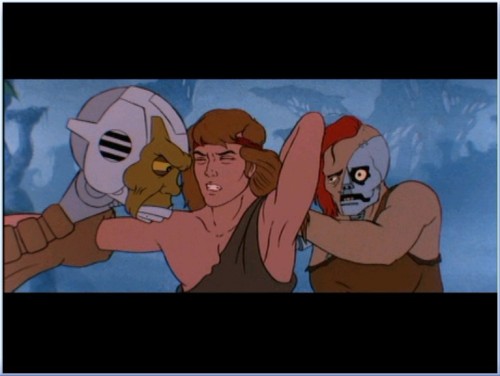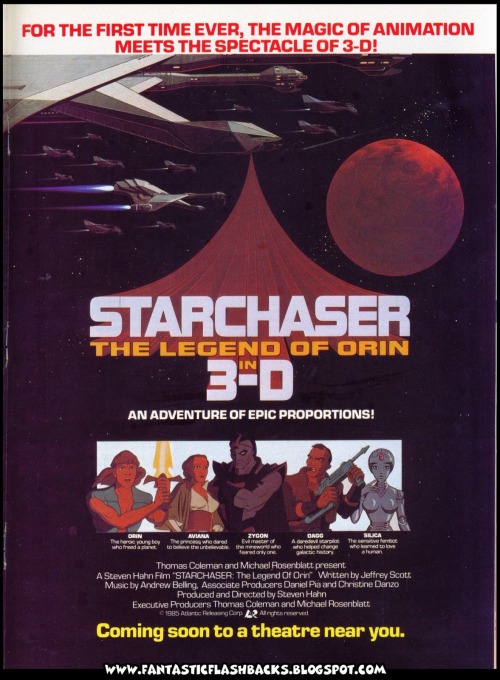#the legend of orin
Starchaser: The Legend of Orin (1985)
Starchaser: The Legend of Orin
A United States / South Korea co-production
Released in 1985
This 1985 animated sci-fi adventure film was one of the first full-length animated movies to mix hand drawn and computer generated animation. It was also the second ever animated feature film to be made and released in stereoscopic 3D.
Dick Sebast began as director in 1982 and devised the program for the 3D spaceships before Steven Hahn took over as director. The 3D ships were computer drawn onto paper, then transferred to cels which were inked just like the characters so they fit right in.
The film employed the use of computer vector-based graphics for the vehicles seen throughout that would be plotted out on paper first and then transferred to cels for the final production. The Walt Disney Animation Studio would later use this same technique for the Big Ben sequence in their 1986 animated feature film The Great Mouse Detective.
In many of the scenes, Starchaser featured the use of actual stereo pairs of hand-drawn images and computer-assisted stereography to produce true volumetric roundness that appeared as line art on screen.
Steven Hahn, Director: “I thought that science-fiction worked best when everything seemed real to the audience. That’s the best way to evoke emotion. And the cartoony style of Saturday morning animation wouldn’t have done the job. So I wanted realism as much as possible. It’s much harder to draw realistic characters, but I thought it would render a more emotional experience. And then I thought, if we can create that realistic setting in three-dimensions, it would work even better! So that’s why I decided to do it in 3D. And so, I assembled the crew, including John Sparey as a scene planner in 3D modeling.”
[Sparey worked with Ralph Bakshi on Fritz the CatandFire and Ice.]
Steven Hahn: “He worked on our graphics program for about six months. And later, Bill Kroyer joined the crew in our computer graphics area to fine tune things even further.”
[Bill Kroyer was the CGI artist on Disney’s Tron.]
Steven Hahn: “On Starchaser, we had the first computer graphics program that actually had a pen that could draw in 3D.”
Jeffrey Scott, Screenwriter: “A digital plotter.”
Steven Hahn: “It was the first time in animation!”
Jeffrey Scott: “The ship in Starchaser was created that way. Never been done before.”
Hahn hired computer visual effects artist John Sparey to work out a method to produce hand-drawn computer-assisted stereo pairs of art. After top, bottom, front, and back drawings of objects had been made on graph paper, the drawings were then encoded into a computer so that mathematical structures of the x, y, and z coordinates existed in the computer’s memory. These coordinates could then be used to create and output multiple points of view of the object.
Since the single-strip 3D 35mm film system was used for production, a two-pass system for photographing the cel art was used. One pass was made to record the 2-perf high left eye image on the film. Then a second pass was made to record the 2-perf right eye image. Each 4-perf frame with single-strip 3D contains the alternately stacked left and right eye frames.
The real unsung hero of this project was cameramen who had to do multiple passes for the 3D layers, effects, and adjust them for each eye without mistakes.
Steven Hahn: “All the spatial movements were accomplished with that program. There was no other way we could calculate it correctly.”
Steven Hahn: “We didn’t use any rotoscoping. I was working with Ralph Bakshi as a subcontractor, and he’d made films like Wizards with some rotoscoping. So I got to learn exactly what it actually does on the screen. But there’s no rotoscoping in Starchaser.”
Jeffrey Scott: “That’s what made it so much more difficult to create. Steven’s animators were hand-drawing human characters and getting them to move realistically. It’s the most difficult thing there is because we’ve all seen humans move and know exactly what they’re supposed to look like. There’s no margin for error. But we’ve never seen Porky Pig in real life, so Porky can squash and stretch himself and do all kinds of things and we never question it.”
Produced and directed by Steven Hahn with an international team of animators and technicians, Starchaserwas primarily produced with conventional line art animation using hand-drawn and hand-painted cels. This produced a planar look in 3D similar to much of the art in 3D comic books or View-Master cartoon reels.
Steven Hahn: “Basically, we’re dealing with a 2D medium of cel animation and turning it into 3D. This creates problems well beyond those found in an ordinary 3D live-action feature which employs objects that are already three-dimensional.”
Steven Hahn: “Pre-production and post-production were done here in the United States, and some key scenes in animation, as well. But most of it was animated in Korea. We constantly shipped footage back and forth. It was very difficult, because they’d animate a shot in Korea, and then send it over to the United States, and we’d view it in our screening room in 3D. Well, sometimes it worked correctly, and sometimes it didn’t! So we’d ask them to redo it and the process would continue like that, twice for each shot! Twice because our 35mm film was split across the middle. Top and bottom. Over and under.”
Jeffrey Scott: “Left eye, right eye.”
Steven Hahn: “For 3D, our cameraman would shoot an image for the top half of the film. And then we’d rewind the film and do the same shot again for the bottom half. So our 35mm frame was split horizontally, and it had the same movie on both halves, just slightly different. Sometimes we’d have an effect, like a laser or something, and we’d have to go back and forth twenty times! Because if one frame is off, the 3D just doesn’t work. In the middle of all that, I thought I was crazy. I had, probably, about five million dollars of my own money invested in the film. But the budget turned out to be closer to fourteen-million. I thought it would take six months to complete. It took three years! The execution on my part is nowhere near what I wanted to do, because of the technical difficulties and the size of the production. I had quite a number of people on staff in Korea and quite a number of people here in the United States. At one time I had almost ninety people on payroll!”
John Van Vliet and his Available Light Effects company in North Hollywood handled the two-pass photography for Starchaser.
Vliet: “The camera end of it was sort of a nightmare. The 3D was like doing two films at once because you had to do a left-eye and a right-eye version. But, by the time we finished doing some of the multiple passes it felt like four films!”
Post link
Starchaser: The Legend of Orin · A United States / South Korea co-production
Released in 1985 · Second ever 3D feature-length animated film in history
Running Time: 107 Minutes· Directed By: Steven Hahn
Jeffrey Scott, Screenwriter: “I wrote it as a live-action script. My viewpoint on Starchaser was just to write a good sci-fi epic. I had no consideration that I was writing animation. Basically, I wanted real characters in a live-action story. I pushed the envelope from a kid’s standpoint with a little sexual innuendo, but I didn’t write it just for kids.”
Jeffrey Scott: “There’s a sword-in-the-stone element to it. But you know, these are the archetypical things that are just there so that people can better identify with them. When I was developing the plot, I wasn’t looking at any of those things individually and trying to work them in. My initial concept was, what would it be like to live under ground where the ceiling was so low that you could never stand up fully? That was my first idea. What kind of existence would that be? From there, I built all the rest. How would you find your way out? Well, you’d dig something up! My favorite line in the movie is: ‘Never dig up, because up is Hell!’ So I just reversed our own, standard religious viewpoint. I didn’t set out to add any specific Bible imagery. I was just trying to tell a story. And at the climax, when the glowing figures arrive, what I was really saying was that we’re all spiritual beings. The scene where Orin heals his brother’s blindness was a similar thing. It was a way to show that there’s something going on beyond the physical realm. I admit it was a stretch. If I was to write the script today, I don’t know if I’d make his blind brother see again.”
Steven Hahn, Director: “I thought that science-fiction worked best when everything seemed real to the audience. That’s the best way to evoke emotion. And the cartoony style of Saturday morning animation wouldn’t have done the job. So I wanted realism as much as possible. It’s much harder to draw realistic characters, but I thought it would render a more emotional experience. We didn’t use any rotoscoping. There’s no rotoscoping in Starchaser.”
Jeffrey Scott: “That’s what made it so much more difficult to create. Steven’s animators were hand-drawing human characters and getting them to move realistically. It’s the most difficult thing there is because we’ve all seen humans move and know exactly what they’re supposed to look like. There was no margin for error.”
Post link
Starchaser: The Legend of Orin · A United States / South Korea co-production
Released in 1985 · Second ever 3D feature-length animated film in history
Synopsis:
Set in the deep underground Mine-World, a tribe of human workers are treated like slaves under the power of the evil overlord Zygon, whom they believe to be their god. These slave workers have lived underground for millennia mining crystals for the malevolent Zygon. They have been told for centuries that their world is the only world and any attempt to mine to the surface will only lead them to Hell. Until one day while mining, one of this band of worker-slaves, Orin, discovers and unearths the hilt of a mythical sword with powers only he can unlock and master. The sword issues a message urging Orin to journey to the surface, saying that if he can find the blade of the sword he can set his people free. Upon escaping to the surface of this planet, Trinia, he runs into the rogue smuggler Dagg and a pair of helpful droids and the Princess of Trinia, Aviana. Orin teams up with the reluctant smuggler Dagg and his ship, Starchaser, to search for the sword’s blade. Once all teamed up, they plan to return to the subterranean Mine-World to defeat Zygon and free Orin’s enslaved people.
Post link
Title:Starchaser: The Legend of Orin
Release Year: 1985
Production Country: United States, South Korea (Pre-production and post-production were done here in the United States, and some key scenes in animation, as well. But most of it was animated in Korea.)
Film Director: Steven Hahn
Animation Studios: Young Sung Production Co. Ltd., Steven Hahn Productions, Filmation
Medium: 90% hand drawn / hand-painted cel animation, 10% vector-based computer generated graphics. Starchaserwas the second 3D feature-length animated film in history. The film featured the use of actual stereo pairs of the hand drawn images, which the cameramen had to do multiple passes for the 3D layers. Since the single-strip 3D 35mm film system was used for production, a two-pass system for photographing the cel art was used. One pass was made to record the 2-perf high left eye image on the film. Then a second pass was made to record the 2-perf right eye image. Each 4-perf frame with single-strip 3D contains the alternately stacked left and right eye frames. The film was a stereoscopic 3D production, shot in 2.35:1 widescreen.
Genre: sci-fi, adventure
Length: 107 minutes




